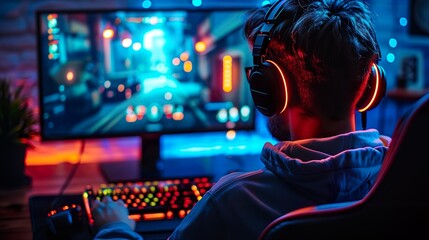Artificial Intelligence (AI) has rapidly evolved from a futuristic concept into a transformative force in various industries, with the gaming sector being one of the most significant beneficiaries. The integration of AI in gaming has not only enhanced the gaming experience for players but also revolutionized the way games are developed and managed. Coders, the architects behind these digital experiences, are at the forefront of this revolution, using AI to push the boundaries of what is possible in gaming. This article delves into how coders utilize AI in the gaming industry, exploring its various applications, the challenges faced, and the future prospects of AI-driven gaming.
Understanding AI in Gaming
Artificial Intelligence in gaming refers to the use of algorithms and machine learning techniques to create responsive, adaptive, and intelligent behaviors in non-playable characters (NPCs), environments, and game mechanics. Unlike traditional coding methods, where behaviors are pre-programmed, AI allows these elements to learn from player interactions and evolve over time. This adaptability enhances the gaming experience by making it more dynamic and personalized.
Coders employ AI in gaming for a variety of purposes, ranging from simple tasks like pathfinding for NPCs to complex processes like generating entire game worlds procedurally. The use of AI in gaming can be categorized into two main areas: in-game AI and AI in game development. In-game AI focuses on the behaviors and interactions within the game, while AI in game development streamlines the creation process, making it more efficient and innovative.
Enhancing NPC Behavior with AI
One of the most prominent applications of AI in gaming is in the development of non-playable characters. Traditionally, NPCs followed predetermined scripts, leading to repetitive and predictable behavior. However, with the advent of AI, coders can create NPCs that exhibit more complex and lifelike behaviors. Machine learning algorithms allow NPCs to learn from player actions and adapt their strategies accordingly, making the gameplay more challenging and engaging.
For example, in stealth games, AI-driven NPCs can analyze player patterns and develop counter-strategies, forcing players to continuously adapt their approach. This level of sophistication not only enhances the challenge but also adds depth to the gameplay, as players must think strategically to outsmart the AI. Coders achieve this by using reinforcement learning, a type of machine learning where NPCs are programmed to learn from their successes and failures, gradually improving their performance over time.
Also Read: Game Development with Rosebud AI: The Future of AI-Driven Tools in Gaming
Procedural Content Generation
Another significant application of AI in gaming is procedural content generation (PCG). PCG refers to the use of algorithms to automatically create game content, such as levels, maps, or even entire game worlds. This approach allows for virtually infinite possibilities, as each player’s experience can be unique. Coders use AI-driven algorithms to generate environments, quests, and challenges that are tailored to the player’s preferences and playstyle.
Games like “No Man’s Sky” have utilized procedural content generation to create vast, explorable universes with billions of planets, each with its own unique ecosystem. AI enables this by using complex algorithms that consider various factors, such as environmental conditions, player progress, and game balance, to generate content that feels natural and coherent. Coders play a crucial role in fine-tuning these algorithms, ensuring that the generated content is not only diverse but also enjoyable and meaningful.
Dynamic Difficulty Adjustment
AI also plays a vital role in dynamic difficulty adjustment (DDA), a technique that tailors the game’s difficulty based on the player’s skill level. Coders use AI algorithms to monitor player performance in real-time, adjusting the game’s challenge to keep it engaging without being frustrating. For instance, if a player is struggling with a particular section of a game, the AI might lower the difficulty temporarily to help them progress. Conversely, if the player is breezing through the game, the AI can increase the difficulty to maintain the challenge.
This dynamic adjustment ensures that the game remains enjoyable for a wide range of players, from casual gamers to hardcore enthusiasts. Coders implement DDA by integrating machine learning models that analyze player behavior and predict the optimal difficulty level. This approach not only enhances the player’s experience but also increases the game’s replayability, as players are more likely to return to a game that consistently challenges them at the right level.
AI in Game Testing and Quality Assurance
Beyond in-game applications, AI is also transforming the game development process, particularly in testing and quality assurance. Traditional game testing is a time-consuming and labor-intensive process, as testers must play through various scenarios to identify bugs and issues. However, AI-driven testing tools can automate much of this process, significantly reducing the time and resources required.
Coders develop AI algorithms that can simulate thousands of playthroughs, identifying potential issues that human testers might miss. These AI tools can also perform stress testing by running the game in extreme conditions, ensuring that it remains stable under various scenarios. By automating these tasks, coders can focus on more creative aspects of game development, leading to higher-quality games with fewer bugs and glitches.
Personalized Gaming Experiences
Personalization is a growing trend in the gaming industry, and AI is at the heart of this movement. Coders are using AI to create personalized gaming experiences that cater to individual player preferences. This can range from customizing game content based on player choices to using AI-driven algorithms to recommend games and in-game items that align with the player’s interests.
For example, AI can analyze a player’s past behavior, such as the types of games they play, the characters they prefer, and their playstyle, to offer personalized content suggestions. This level of personalization enhances player engagement, as the game feels more tailored to their tastes. Coders achieve this by integrating machine learning models that analyze player data and predict their preferences, allowing for a more immersive and enjoyable gaming experience.
Challenges in Implementing AI in Gaming
While the benefits of AI in gaming are clear, implementing AI-driven systems is not without its challenges. Coders face several obstacles, including the complexity of AI algorithms, the need for large datasets to train these algorithms, and the challenge of balancing AI-driven systems with player expectations.
One of the main challenges is ensuring that AI behaves in a way that is both challenging and fair. If AI-driven NPCs become too unpredictable or difficult, it can lead to player frustration. On the other hand, if the AI is too easy to outsmart, it can diminish the game’s challenge. Coders must strike a delicate balance, fine-tuning AI algorithms to provide the right level of difficulty while ensuring that the gameplay remains enjoyable.
Another challenge is the ethical implications of AI in gaming. As AI systems become more advanced, there are concerns about privacy and data security, particularly when it comes to personalized gaming experiences. Coders must navigate these ethical considerations, ensuring that player data is used responsibly and that AI-driven systems do not infringe on player rights.
The Future of AI in Gaming
The future of AI in gaming holds immense potential, with coders continuing to push the boundaries of what is possible. As AI technology advances, we can expect even more sophisticated NPC behaviors, more personalized gaming experiences, and more efficient game development processes. Virtual reality (VR) and augmented reality (AR) are also areas where AI is likely to play a significant role, creating more immersive and interactive gaming experiences.
In the coming years, AI-driven games could become more adaptive, learning not only from individual players but also from entire player communities. This could lead to games that evolve over time, responding to trends and player feedback in real-time. Coders will play a crucial role in this evolution, using AI to create games that are more engaging, immersive, and dynamic than ever before.
Last Words
AI has already made a profound impact on the gaming industry, and its influence is only set to grow in the coming years. Coders are at the forefront of this revolution, using AI to create more intelligent NPCs, generate dynamic content, personalize gaming experiences, and streamline the game development process. While there are challenges to overcome, the potential of AI in gaming is vast, promising a future where games are more immersive, engaging, and tailored to individual players. As AI continues to evolve, so too will the possibilities for innovation in the gaming industry, making it an exciting time for both gamers and developers alike.
FAQs
Q1: What is AI’s role in the gaming industry?
AI plays a pivotal role in the gaming industry by enhancing the intelligence and responsiveness of non-playable characters (NPCs), generating dynamic and personalized game content, and improving overall game mechanics. Coders use AI to create more engaging and immersive experiences for players, allowing games to adapt and evolve based on player behavior.
Q2: How do coders implement AI in game development?
Coders implement AI in game development through various techniques, such as machine learning, procedural content generation, and dynamic difficulty adjustment. They use AI algorithms to analyze player actions and preferences, enabling the game to offer personalized experiences and smarter in-game challenges.
Q3: What are some examples of AI-driven features in games?
Examples of AI-driven features in games include adaptive NPC behavior, where characters learn and evolve based on player interactions; procedural content generation, which creates unique game worlds or levels; and dynamic difficulty adjustment, which tailors the game’s challenge to the player’s skill level.
Q4: How does AI improve NPC behavior in games?
AI improves NPC behavior by allowing characters to react intelligently to player actions, making them more realistic and challenging. Coders use AI algorithms to program NPCs that can learn from previous encounters, adapt their strategies, and provide a more engaging gameplay experience.
Q5: What is procedural content generation in gaming, and how is AI involved?
Procedural content generation (PCG) refers to the use of algorithms to automatically create game content, such as levels, maps, or quests. AI is involved in PCG by generating content that is tailored to the player’s preferences and ensuring that each gaming experience is unique and dynamic.
Q6: Can AI make games more personalized for players?
Yes, AI can significantly personalize games for players. By analyzing player behavior and preferences, coders can use AI to customize various aspects of the game, such as difficulty, in-game rewards, and even the storyline, making the experience more engaging and suited to individual players.
Q7: What challenges do coders face when using AI in gaming?
Coders face several challenges when using AI in gaming, including ensuring that AI-driven behaviors are balanced and fair, managing the complexity of AI algorithms, and addressing ethical concerns related to data privacy and security. Additionally, AI must be carefully designed to enhance the gaming experience without frustrating players.
Q8: How does AI contribute to game testing and quality assurance?
AI contributes to game testing and quality assurance by automating many of the repetitive and time-consuming tasks involved in testing. Coders develop AI tools that can simulate numerous playthroughs, identify bugs, and stress-test games under various conditions, leading to more efficient development and higher-quality games.
Q9: What is the future potential of AI in gaming?
The future potential of AI in gaming is vast. As AI technology continues to evolve, it will likely lead to even more sophisticated and adaptive games, with AI-driven characters and environments that can learn and evolve alongside players. Coders will continue to explore new ways to use AI to create richer, more immersive gaming experiences.
Q10: How does dynamic difficulty adjustment work in AI-driven games?
Dynamic difficulty adjustment (DDA) is a technique where AI monitors a player’s performance in real-time and adjusts the game’s difficulty to match their skill level. Coders use AI to ensure that the game remains challenging but not frustrating, providing a balanced and enjoyable experience for players of all skill levels.













